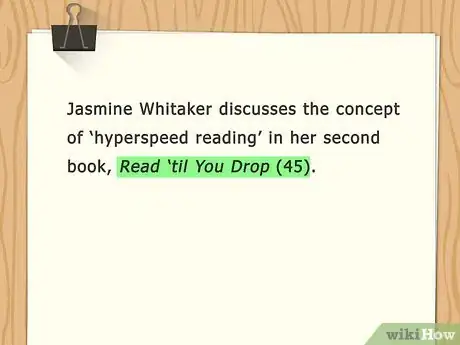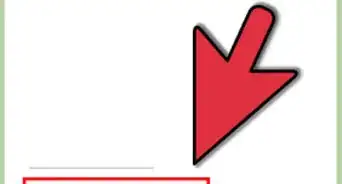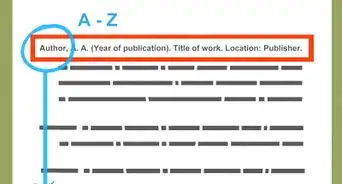This article was co-authored by wikiHow Staff. Our trained team of editors and researchers validate articles for accuracy and comprehensiveness. wikiHow's Content Management Team carefully monitors the work from our editorial staff to ensure that each article is backed by trusted research and meets our high quality standards.
There are 9 references cited in this article, which can be found at the bottom of the page.
This article has been viewed 18,381 times.
Learn more...
Use numeric citations to simplify the paper-writing process and keep your citations organized. Use only one number for each source you cite, and repeat the number if you reference the source in multiple parts of the paper. Format the numbers in brackets or superscript, and add page numbers if you are referencing a page-specific item. When you compile your reference list, include specific details about the sources you’ve used (e.g., dates, article titles, specific web addresses). Be sure to find out what type of numeric citation you are expected to use.
Steps
Numbering Each Source Individually
-
1Place a number directly after listing the source. Numerical citations should be placed in sequence throughout the paper, starting with “1”. The citations should go directly after a mention of a source (e.g. “In his final publication, Foucault (16) claimed that…”) Format your numerical citations in round brackets, square brackets, or superscript.[1]
- When referring to indirectly to a source, place the number at the end of your sentence. For instance, “Gender is a social construct perpetuated by social norms (3).”
-
2Include page numbers when necessary. Add a page number to the in-text portion of your numeric citation if you’ve borrowed content from a specific part of a document. This may include using a table, picture, or diagram from a source, or borrowing a concept or argument specific to a certain part of a document. To reference multiple pages, use the abbreviation “pp.” instead of “p.”.[2]
- For example, "The author made a comparison between modern photography and portrait painting (6, p. 47)..."
- If the page numbers are listed in roman numerals, do not include the abbreviation “p.” or “pp.” in front of them.
Advertisement -
3Use the same citation number for the same source. Do not use more than one number for the same document. If you cite the same source more than once in a paper, re-use the number that you used initially. If you are referencing a different part of the text, indicate a page number or a section number.[3]
-
4Group together multiple citations. If you cite more than one source in the same sentence, there are two options for how to format it. Group the citation numbers together by placing the numbers in the same set of brackets, separated by commas. Alternatively, present each citation number in its own set of brackets, and separate these individual citations with commas.[4]
- For instance, write either “Several recent studies [3,5,6] have suggested that..." or “Several recent studies [3], [5], [6] have suggested that...".
- If you are using superscript for your numeric citations, place the citation numbers together, separated by commas.[5]
-
5Put quotation marks around direct quotations. Indicate direct quotes from a source clearly, with quotation marks. If you are inserting a long quote (more than four sentences) into your text, indent the block quotation. Avoid using overly long quotes unless they are directly pertinent to your paper.[6]
- E.g., “McLuhan wrote, “the medium is the message” (12)…”.
Composing a Reference List
-
1List sources in numerical order. Add a list of your citations at the end of your work. All references should be listed in the numeric order they follow in your text, and not alphabetically. Add the heading “References” to this list.[7]
-
2Cite all authors of a document. If a source has multiple authors, list all of them in the full citation. Write each author’s family name, then the initial of their first name separated by a comma. The word and should be included before the final author’s name. List authors in the same order that they are listed on the publication.[8]
- E.g., "James, E and Dean, M. A Study of Social Media Trends. Washington: Good Books Publishing, 2014."
-
3Provide specific details for web citations. For the sake of precision, reference specific parts of websites instead of just the general homepage. Look for the credits, document titles, and publication years to provide complete references. A full website reference should include:[9]
- The name of the author or editor
- The title of the website
- The year it was last updated
- The word "online" in brackets
- The phrase “Available from:”, followed by the complete URL address
- The date you accessed the information
- E.g., "Dalton, R. Science Online. 2015. [Online] Available from: http://www.scienceonlinewebsite.org [Accessed November 30, 2016]."
-
4Cite journal articles with specific page numbers. Journal articles should be cited with specific details, including the issue number and the article’s page number. If a journal article is available both in print and online, cite the paper version. Be sure to include all the necessary information, which includes:[10]
- The last name and first initial of the author
- The title of the article
- The title of the journal, written in italic font
- The year it was published
- The issue number of the journal
- The page numbers for the article you are referencing
- E.g., "Franco, L. Nostalgia in Film: A Study of Longing in Modern Cinema. Journal of Fun Film Studies. 2008. 54(4) p. 240."
Using Alternate Types of Numeric Citations
-
1Number each citation individually. For a different approach to numerical citation, use citation numbers in sequence without repeating any numbers. If you use the same source at different points in the paper, assign a new number to each individual citation every time you use it. List the source in your reference list as many times as it is used.
-
2Number each citation alphabetically. Another method of numerical citation involves compiling your sources and writing them alphabetically in your reference list. When citing a source in your paper, add the number that corresponds to it in your reference list. A reference with the numeric citation “(1)” should correspond to the first source listed alphabetically in your reference list.[11]
-
3Ask your instructor or editor what version you should use. Make sure that you are using the correct style of numeric citation by asking your instructor or editor exactly what they expect from you. Inquire about what form your citations should be in (e.g., superscript, square brackets). You should also ask how the reference list should be formatted.[12]
References
- ↑ https://www.dit.ie/media/library/documents/Numeric.pdf
- ↑ https://library.leeds.ac.uk/skills-citations-numeric#activate-when_to_include_page_numbers
- ↑ https://www.dit.ie/media/library/documents/Numeric.pdf
- ↑ http://libguides.murdoch.edu.au/IEEE/text
- ↑ https://library.leeds.ac.uk/skills-citations-numeric#activate-when_to_include_page_numbers
- ↑ https://www.dit.ie/media/library/documents/Numeric.pdf
- ↑ http://guides.lib.uw.edu/c.php?g=99161&p=642357
- ↑ https://library.leeds.ac.uk/skills-referencing-numeric#activate-multiple_authors
- ↑ https://www.dit.ie/media/library/documents/Numeric.pdf





















-Step-18.webp)

















































